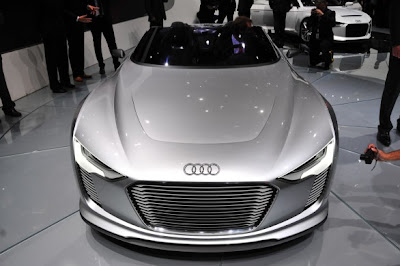
At the 2010 Paris Motor Show Lamborghini has unveiled its much-awaited concept car: the Sesto Elemento. Featuring a full carbon-fiber structure and body, the V10-powered technological demonstrator has a weight of 999 kg and sprints from 0 to 100 km/h in 2.5 seconds.


After six teasers and many rumors, Lamborghini has finally unveiled its new stunning concept car.
Its name is "Sesto Elemento", which is the Italian translation of "Sixth Element", and refers to the position of carbon in the periodic table.
The name underlines the importance role payed by carbon-fiber reinforced plastics (CFRP) technology: in the Sesto Elemento the carbon fiber is used for the front frame, body panels, crash boxes, major suspension components and rims.

The result is an extremely lightweight construction, with an overall curb weight of just 999 kg.
To further emphasize the use of this technology, the exterior is finished in a matt-shimmer clear coat, that lets the CFRP structure and its texture completely visible.
The Sesto Elemento is powered by a 5.2 liter V10 engine that deliver 570 hp - which means a power-to-weight ratio of only 1.75 kg/hp - coupled with a permanent all-wheel drive transmission.

It can accelerate from 0 to 100 km/h (62 mph) in just 2.5 seconds ad the top speed is over 300 km/h.
The concept is considered by the Italian carmaker as a technological demonstrator that will inspire and influence all the future model line-up.
Stephan Winkelmann, President and CEO of Automobili Lamborghini, has commented: "Systematic lightweight engineering is crucial for future super sports cars: for the most dynamic performance, as well as for low emissions.
"We will apply this technological advantage right across our model range. Every future Lamborghini will be touched by the spirit of the Sesto Elemento."

Exterior Design
Lamborghini Sesto Elemento Concept TeaserThe design of the Sesto Elemento Concept is an evolution of the brand's language and integrates the carbon-fiber as a visual element.
The body is finished in a matt-shimmer clear coat which includes fine crystals with a red shimmer and lets the that the CFRP structure visible throughout.
In order to optimize the construction, the body-shell exterior consists of just few integrated elements: the roof section, which is part of the monocoque, the two front and rear covers with integrated aerodynamic components and the doors,
The doors are made of only two components, the exterior skin and the interior cladding, permanently bonded together.
The front and rear main panels are manufactured in a single piece, called "cofango", a name created by combining the Italian word "cofano" (hood) with "parafango" (fender).
The large components are attached by using easily removable fasteners.
The "cofango" is also reminiscent of the 1966 Lamborghini Miura, which had a rear cover that could be opened in one single piece.
The surfaces have precisely-defined and sharp edges, created with functionality in mind. The main design theme is provided by the recurring triangular and polygonal elements: from the red openings in the hood to the sharply cut headlamp units, the side mirrors and the door handles.
The entire side profile is cut like a sharp wedge, with the power center of the car just in front of the rear axle. A distinctive sideline starts at the front wheel arch, rises along the door towards the rear and ends at the broad shoulders above the rear wheel.
The wide sills form a connection between the air outlets behind the front wheels and the large air inlets in front of the rear wheels. These house components such as the radiators for cooling the engine and transmission oil.
The rims have a five-spoke design and are made entirely from carbon fiber. They offer a clear view of the high-performance brakes with carbon-ceramic discs.
The Sesto Elemento's rear end features a short overhang, a generously dimensioned spoiler, matched by adiffuser and an additional air deflector in the center.
The tailpipes are made of Pyrosic (an advanced glass-ceramic matrix composite) and are directed upwards through the engine cover panel, which incorporates ten hexagonal openings and two air scoops behind the roof.
The tailpipes are made from Pyrosic, which is an advanced glass-ceramic matrix composite, able to reach and stand very high temperatures up to 900° celsius. Even the propeller shaft is made of CFRP.

Interior Design
Lamborghini Sesto Elemento Concept InteriorLike the exterior, the interior uses a minimalistic approach.
The seats do not have a conventional seat frame, but an internal structure obtained and defined directly from the Forged Composite tub, that on one side plays a functional role and on the other side is the base for the optimally formed seat cushions, upholstered in hi-tech fabric, which are affixed directly to the carbon-fiber monocoque.
The the steering wheel, which can be adjusted for height and reach, and by the pedals, which can be electrically adjusted longitudinally.

The dominant visual element is the CFRP material texture - on the floor and roof of the monocoque, on the doors and also on the cockpit and center console. Even the electronic control unit for the engine is mounted in plain sight.
The design is also characterized by the numerous triangular cut-outs aimed at maximizing the weight reduction.
The controls are presented in a highly concentrated format.
The center console includes only three piezoelectric buttons - one to start the engine, one to shift into reverse gear and another one for the lights.

Lamborghini and the CFRP Technology
Lamborghini Sesto Elemento Concept TeaserLamborghini has mastered the complete CFRP process across a range of technologies, from 3D design through simulation, validation, production and testing – all in a state-of-the-art industrial process that stands for the very highest quality standards.
The company drives the technology development in its two research centers the ACRC (Advanced Composite Research Center) and the ACSL (Advanced Composite Structures Laboratory) through collaborations with organizations such as Boeing, with the resulting technology secured under a host of patents.
(Source: Lamborghini)

























































